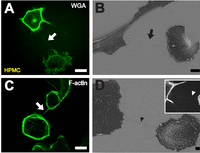
Photo from wikipedia
Summary Bone-resorbing osteoclasts play a central role in bone remodeling and its pathology. To digest bone, osteoclasts re-organize both F-actin, to assemble podosomes/sealing zones, and membrane traffic, to form bone-facing… Click to show full abstract
Summary Bone-resorbing osteoclasts play a central role in bone remodeling and its pathology. To digest bone, osteoclasts re-organize both F-actin, to assemble podosomes/sealing zones, and membrane traffic, to form bone-facing ruffled borders enriched in lysosomal membrane proteins. It remains elusive how these processes are coordinated. Here, we show that ARAP1 (ArfGAP with RhoGAP domain, ankyrin repeat and PH domain-containing protein 1) fulfills this function. At podosomes/sealing zones, ARAP1 is part of a protein complex where its RhoGAP domain regulates actin dynamics. At endosomes, ARAP1 interacts with AP-3 adaptor complexes where its Arf-GAP domain regulates the Arf1-dependent AP-3 binding to membranes and, consequently lysosomal membrane protein transport to ruffled borders. Accordingly, ARAP1 or AP-3 depletion in osteoclasts alters their capacity to digest bone in vitro. and AP-3δ-deficient mocha mice, a model of the Hermansky-Pudlak storage pool syndrome, develop osteoporosis. Thus, ARAP1 bridges F-actin and membrane dynamics in osteoclasts for proper bone homeostasis.
Journal Title: iScience
Year Published: 2018
Link to full text (if available)
Share on Social Media: Sign Up to like & get
recommendations!